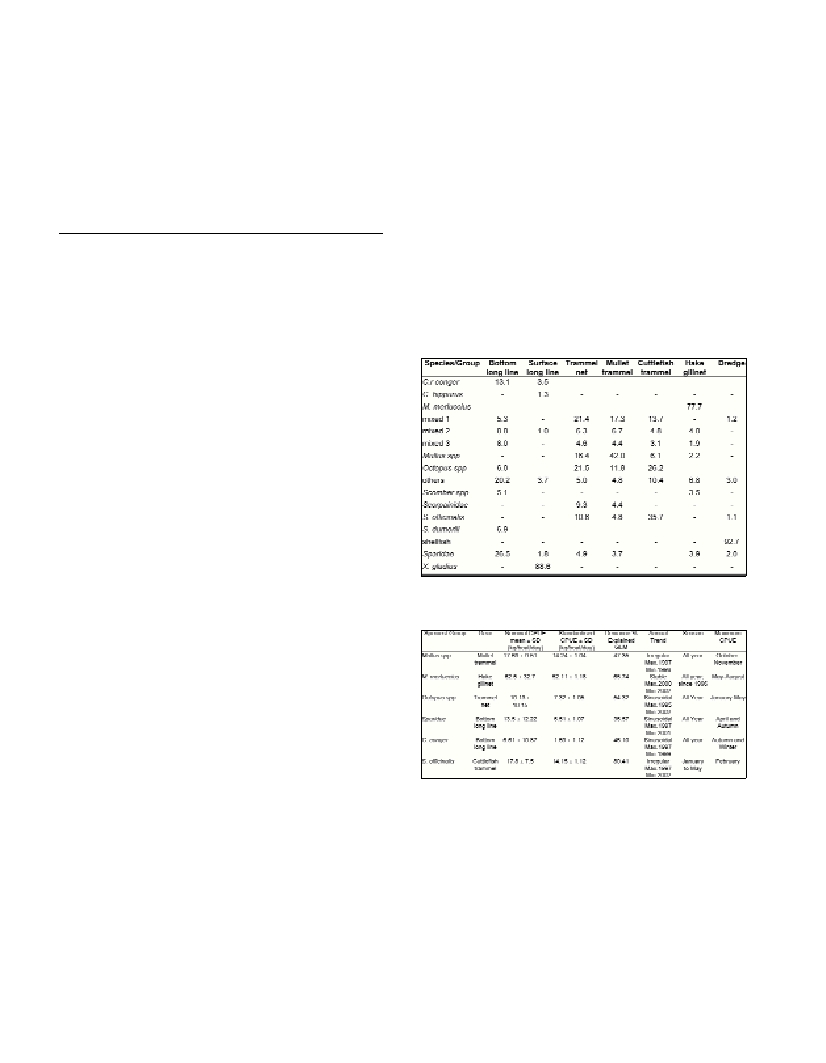SMALL-SCALE FISHERIES OF THE ALICANTE GULF:
THE CASE OF SANTA POLA PORT AS A PRELIMINARY APPROACH
Mariano García-Rodriguez
1
* and Angel M. Fernández
2
1
Instituto Español de Oceanografía, Servicios Centrales, Madrid, Spain - * mariano.garcía@md.ieo.es
2
Instituto Español de Oceanografía, Centro Oceanográfico de Murcia, San Pedro del Pinatar, Murcia, Spain
Abstract
The artisanal ?eet operating in Alicante Gulf was analysed from data collected at the Santa Pola port using, multivariate analysis and GLM.
Monthly landings/boat from 1994 to 2002 were used to describe activity groups, identify discriminant species, characterise catch
composition by gear and obtain a derived abundance index for selected species. The results suggested that the fishery was more or less
stable throughout the years.
Key-Words: Small-scale fisheries, Western Mediterranean, Spain
Rapp. Comm. int. Mer Médit., 37,2004
361
Introduction
Small-scale fisheries in the Spanish Mediterranean are of limited
importance when compared with trawl and purse seine fisheries.
Nevertheless, its social and economic importance is high. The
artisanal ?eet exceeds 2,800 small (< 10 m) boats using more than 20
different gears, usually two or more per boat. It is characterised by
highly diversified catches in terms of species as well as by wide
geographic dispersion of landings, a fact rendering data collection
difficult. In Alicante Gulf, 12 ports with artisanal activity exist, with
more than 150 boats landing daily. The Santa Pola port represents
more than half of the activity (57% of boats), with more than 300 t
landed per year.
Materials and methods
Monthly landings cumulated by boat and species and without gear
indication were collected from selected vessels that landed more than
100 days per year in the Santa Pola port during 1994-2002 (compiled
by the RIM-IEO). In order to identify different activity groups of the
artisanal ?eet (i.e., métiers), principal components analysis (PCA)
was performed on a matrix containing percentage contribution of 26
species to the total monthly catch by vessel for the period studied. In
addition, agglomerative hierarchical grouping (AHG) was applied to
identify and classify each monthly-landing (vessels) in each
corresponding activity group. The specific composition of the
landings of each group obtained were compared with the specific
composition of the different gears described previously (1) for a
reference year (2000). The comparison allowed us to regroup the
results into groups that defined some of the different gears currently
used in the area. To analyse the variation of the CPUE for the target
species selectedin each case a Generalised Linear Model, GLM, (2),
which included factors such as vessel, year and month was used. The
model chosen was: Ln
µ
cym
=
a
+
d
c
+
?
y
+
?
m
+
e
cym
, where
µ
cym
is the
expected catch rate obtained by vessel class cin year yin month m;
a
is the catch rate obtained by vessel class 1 in January 1994;
d
c
is the
efficiency of vessel class crelative to class 1;
?
y
is abundance in year
yrelative to 1994;
?
m
is abundance in month mrelative to January and
e
cym
is the deviation between the observed catch rates and the
expected value for c. An analysis of deviance was carried out in order
to evaluate the significance of the factors in the model. Analyses were
performed using S-PLUS 2000 (3).
Results and discussion
The total number of selected boats during the 9-year period was 51
(mean: 25 different boats/year). PCA showed that 6 main components
explained 73% of total variance. The 8 most discriminant species (or
species groups) identified were: Mullus spp., Merluccius merluccius,
Octopus spp., Sparidae, Sepia officinalis, Conger conger, shellfish
(Ruditapes + Donax + Chamelea) and mixed 1 (Sparidae+
Scorpaenidae+ Labridae). Cluster showed 9 main activity groups and
subsequent groupings provided 7 different gears. The most
discriminant species for PCA also defined the gear grouping, as well
as its catch species composition (Table 1). The GLM selected
explained up to 48% of deviance for the total CPUE. The most
important factors identified were vessel (25%), followed by year
(16%) and month (7%). For the species, differences existed between
nominal and standardised CPUE’s, resulting in standardised ones
being lower than nominal ones, especially for C. congerand Sparidae
(Table 2). In general, the fishery was more or less stable with a
maximum CPUE in 1997 decreasing slowly thereafter. Selected
species were fished all year round, with the exception of S. officinalis
(fishing season: January to May). In general, the results agree with
previous descriptions of the fishery in the area (1), suggesting that the
methodology applied can be adequate for use in small-scale fisheries
studies.
Table 1. Specific catch composition and percentage contribution of each
species/ group to total catch, of the seven main gears identified in the
Alicante Gulf area.
Table 2. Main characteristics of the more discriminant species identified
in the analysis.
References
1-Fernández A. M., and Esteban A., 2003. La pesquería artesanal de
Santa Pola (S.E. de la Península Ibérica). Descripción y actividad en el
periodo 1992-2000. Inf. Téc. Inst. Esp. Oceanogr. 181, 49 p.
2-McCullagh P., and Nelder J.A., 1989. Generalized Linear Models (2nd
ed.). Chapman and Hall, London. 509 p.
3-Becker R. A., Chambers, J.M., and Wilks A.R., 1988. The new S
language. A programming environment for data analysis and graphics.
Wadsworth and Brooks/Cole Advanced Books Software, Pacific Grove,
California. 702 p.

